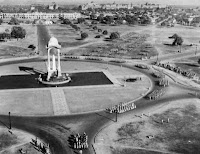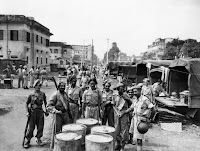 OUR INDIA
OUR INDIAThe partition of Indian subcontinent in 1947, following World War II is perhaps the most tragic of all political events to affect India in its long political history. The partition divided Hindus and Muslims who had lived together for hundreds of years.

 Mahatma Gandhi with Pethwick Lawrence, British Secretary of State for India after a meeting on 18 April 1946
Mahatma Gandhi with Pethwick Lawrence, British Secretary of State for India after a meeting on 18 April 1946
 Aerial view of contingents setting off on the Victory Parade in Delhi in March 1946
Aerial view of contingents setting off on the Victory Parade in Delhi in March 1946 A Colour Party leads the British infantry contingent through India's memorial arch in Delhi during the Victory Parade in March 1946
A Colour Party leads the British infantry contingent through India's memorial arch in Delhi during the Victory Parade in March 1946 Indian Army passes the saluting base during the Victory Parade in Delhi in March 1946. Thousands of spectators watched the Victory Parade in Delhi.
Indian Army passes the saluting base during the Victory Parade in Delhi in March 1946. Thousands of spectators watched the Victory Parade in Delhi.


In 1947, the border between India and its new neighbour Pakistan became a river of blood, as the exodus erupted into rioting. An outbreak of violence a few months after the main riots resulted in the redeployment of the Battalion on the streets of Calcutta. A small British foot patrol on Lower Chitpur Road.
An outbreak of violence a few months after the main riots resulted in the redeployment of the Battalion on the streets of Calcutta. A small British foot patrol on Lower Chitpur Road. Indian Pioneers who were brought in to scatter lime around the city in an effort to prevent the spread of disease from decomposing bodies.
Indian Pioneers who were brought in to scatter lime around the city in an effort to prevent the spread of disease from decomposing bodies. Looted and burnt corrugated iron dwellings near College Square, Calcutta in 1946.
Looted and burnt corrugated iron dwellings near College Square, Calcutta in 1946. Looted and burnt corrugated iron dwellings near College Square, Calcutta in 1946.
Looted and burnt corrugated iron dwellings near College Square, Calcutta in 1946.
 Calcutta police disperse a mob of rioters attacking a Hindu temple on Circular Road during the Calcutta Riot of 1946.
Calcutta police disperse a mob of rioters attacking a Hindu temple on Circular Road during the Calcutta Riot of 1946. Calcutta police regroup during the Calcutta Riot in 1946. An Anglo Indian policeman stands in the centre.
Calcutta police regroup during the Calcutta Riot in 1946. An Anglo Indian policeman stands in the centre. Crowds involved in the Calcutta Riot in 1946. This photograph was taken by Captain Peter Farrant during his service with the York and Lancaster Regiment in India between 1945 and 1947. Thousands of people were killed in the rioting, caused by tensions between Hindus, Muslims and Sikhs. This sparked off further violence in surrounding areas.
Crowds involved in the Calcutta Riot in 1946. This photograph was taken by Captain Peter Farrant during his service with the York and Lancaster Regiment in India between 1945 and 1947. Thousands of people were killed in the rioting, caused by tensions between Hindus, Muslims and Sikhs. This sparked off further violence in surrounding areas.

The 1st Battalion, Royal Inniskilling Fusiliers parade in Fort St George, Madras in August 1947. This was their last parade in Fort St George before India became independent. Jawaharlal Nehru is sworn in as India's first Prime Minister by the outgoing Viceroy, Mountbatten, watched by Lady Mountbatten, in August 1947
Jawaharlal Nehru is sworn in as India's first Prime Minister by the outgoing Viceroy, Mountbatten, watched by Lady Mountbatten, in August 1947 Emergency trains crowded with desperate refugees
Emergency trains crowded with desperate refugees Dividing up a library at the time of 1947 partition
Dividing up a library at the time of 1947 partition The migration was a "massive exercise in human misery,"
The migration was a "massive exercise in human misery," Men, women and children who died in the rioting were cremated on a mass scale. Villagers even used oil and kerosene when wood was scarce.
Men, women and children who died in the rioting were cremated on a mass scale. Villagers even used oil and kerosene when wood was scarce. With the tragic legacy of an uncertain future, a young refugee sits on the walls of Purana Qila, transformed into a vast refugee camp in Delhi.
With the tragic legacy of an uncertain future, a young refugee sits on the walls of Purana Qila, transformed into a vast refugee camp in Delhi. "The street was short and narrow. Lying like the garbage across the street and in its open gutters were bodies of the dead,"
"The street was short and narrow. Lying like the garbage across the street and in its open gutters were bodies of the dead," The massive exchange of population that took place in the summer of 1947 was unprecedented. It left behind a trail of death and destruction. The Indian map was slashed to make way for a new country - Pakistan.
The massive exchange of population that took place in the summer of 1947 was unprecedented. It left behind a trail of death and destruction. The Indian map was slashed to make way for a new country - Pakistan. In a couple of months in the summer of 1947, a million people were slaughtered on both sides in the religious rioting. Here, bodies of the victims of rioting are picked up from a city street.
In a couple of months in the summer of 1947, a million people were slaughtered on both sides in the religious rioting. Here, bodies of the victims of rioting are picked up from a city street. An aged and abandoned Muslim couple and their grand children sitting by the the roadside on this arduous journey.
An aged and abandoned Muslim couple and their grand children sitting by the the roadside on this arduous journey. Over 10 million people were uprooted from their homeland and travelled on foot, bullock carts and trains to their new home.
Over 10 million people were uprooted from their homeland and travelled on foot, bullock carts and trains to their new home. Millions left for their new homeland with smiles on their faces as trains left both India and Pakistan. This is a train to Pakistan being given a warm send-off.
Millions left for their new homeland with smiles on their faces as trains left both India and Pakistan. This is a train to Pakistan being given a warm send-off..jpg) Gandhi listens to Muslims during the height of the warfare which followed the partition of India in 1947.
Gandhi listens to Muslims during the height of the warfare which followed the partition of India in 1947. Mountbatten and Lady Mountbatten meet Mr Mohammed Ali Jinnah, the leader of Pakistan, in 1947.
Mountbatten and Lady Mountbatten meet Mr Mohammed Ali Jinnah, the leader of Pakistan, in 1947. The partition of India in 1947 led to a process which we today probably would describe as "ethnic cleansing". Hundreds of thousands of people were massacred and millions had to move; Muslims from India to Pakistan, Hindus in the opposite direction. Photo shows part of the crowds of refugees which poured into the city of New Delhi.
The partition of India in 1947 led to a process which we today probably would describe as "ethnic cleansing". Hundreds of thousands of people were massacred and millions had to move; Muslims from India to Pakistan, Hindus in the opposite direction. Photo shows part of the crowds of refugees which poured into the city of New Delhi. India before Partition
India before Partition


.jpg)













